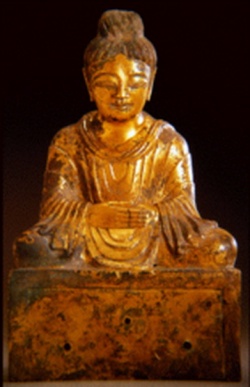Difference between revisions of "Huayan"
m (Text replacement - "fruitful" to "fruitful") |
|||
| Line 1: | Line 1: | ||
[[File:IRg m.JPG|thumb|250px|]] | [[File:IRg m.JPG|thumb|250px|]] | ||
| − | [[HUAYAN]]'. A major [[tradition]] of [[Buddhist]] [[Doctrine]] and practice that emerged in seventh-century [[China]], [[Huayan]] (Jpn., [[Kegon]]; [[Kor]]., [[Hwaŏm]]) was soon transmitted to [[Korea]] and [[Japan]], and has continued even into {{Wiki|modern}} times to exert great [[influence]] on many aspects of [[Religion]], [[Thought]], and {{Wiki|culture}} throughout {{Wiki|East Asia}}. A product initially of the fruitful encounter between [[Mahāyāna]] [[Buddhism]] and [[elements]] of the native {{Wiki|Chinese}} [[religious]] worldview, [[Huayan]] is especially noted for its liberating [[vision]] of the radical interrelatedness or interpenetration of all events and [[experiences]], a {{Wiki|unity}} amidst diversity wherein each and every particular [[Phenomenon]] is seen both to incorporate and be absorbed by all other [[Phenomena]], without ever losing its own unique [[identity]]. | + | [[HUAYAN]]'. A major [[tradition]] of [[Buddhist]] [[Doctrine]] and practice that emerged in seventh-century [[China]], [[Huayan]] (Jpn., [[Kegon]]; [[Kor]]., [[Hwaŏm]]) was soon transmitted to [[Korea]] and [[Japan]], and has continued even into {{Wiki|modern}} times to exert great [[influence]] on many aspects of [[Religion]], [[Thought]], and {{Wiki|culture}} throughout {{Wiki|East Asia}}. A product initially of the fruitful encounter between [[Mahāyāna]] [[Buddhism]] and [[elements]] of the native {{Wiki|Chinese}} [[religious]] worldview, [[Huayan]] is especially noted for its liberating [[vision]] of the radical interrelatedness or interpenetration of all events and [[experiences]], a {{Wiki|unity}} amidst diversity wherein each and every particular [[Phenomenon]] is seen both to incorporate and be absorbed by all other [[Phenomena]], without ever losing its [[own]] unique [[identity]]. |
{{R}} | {{R}} | ||
[http://www.academicroom.com/humanities/religion/buddhist-studies/buddhist-sects/huayan www.academicroom.com] | [http://www.academicroom.com/humanities/religion/buddhist-studies/buddhist-sects/huayan www.academicroom.com] | ||
Latest revision as of 01:20, 30 January 2015
HUAYAN'. A major tradition of Buddhist Doctrine and practice that emerged in seventh-century China, Huayan (Jpn., Kegon; Kor., Hwaŏm) was soon transmitted to Korea and Japan, and has continued even into modern times to exert great influence on many aspects of Religion, Thought, and culture throughout East Asia. A product initially of the fruitful encounter between Mahāyāna Buddhism and elements of the native Chinese religious worldview, Huayan is especially noted for its liberating vision of the radical interrelatedness or interpenetration of all events and experiences, a unity amidst diversity wherein each and every particular Phenomenon is seen both to incorporate and be absorbed by all other Phenomena, without ever losing its own unique identity.
